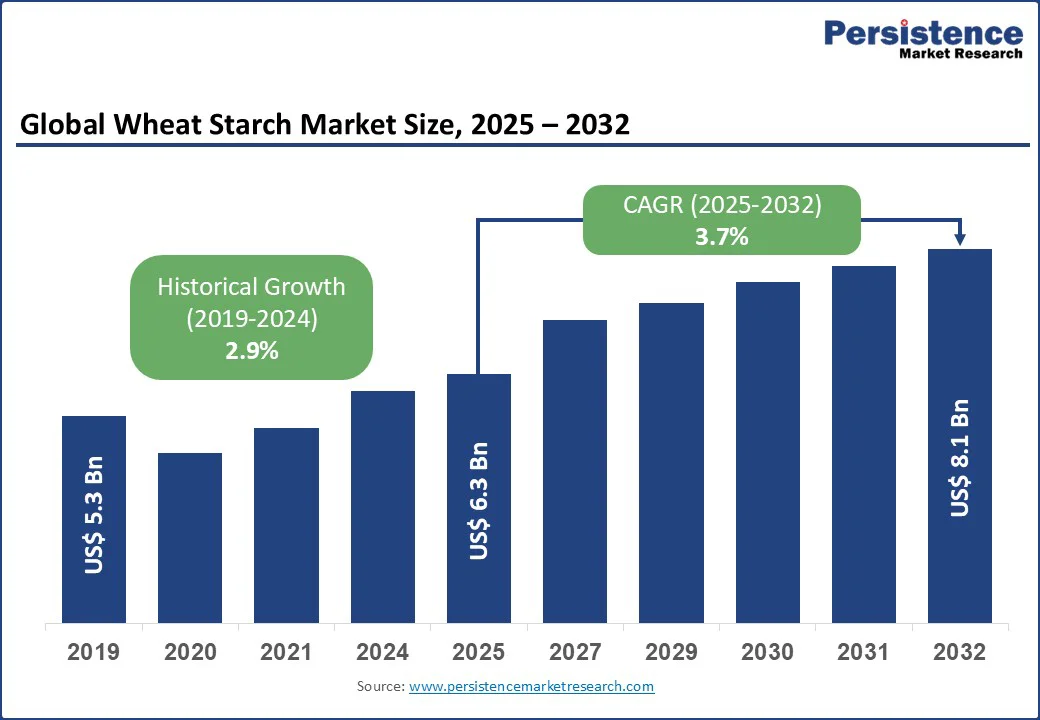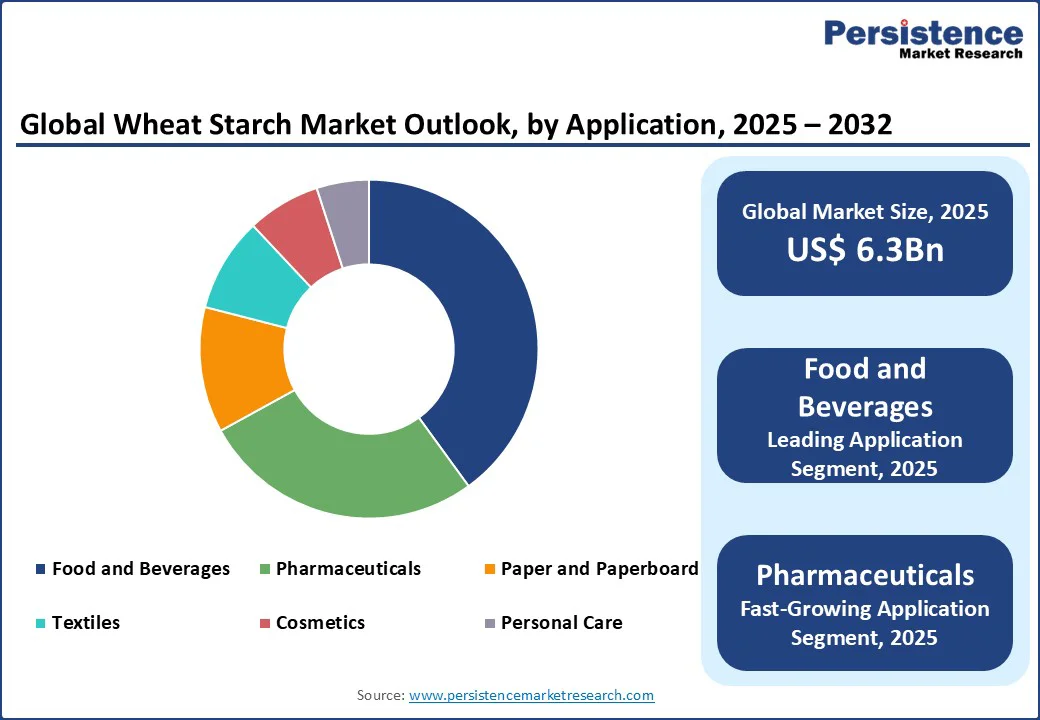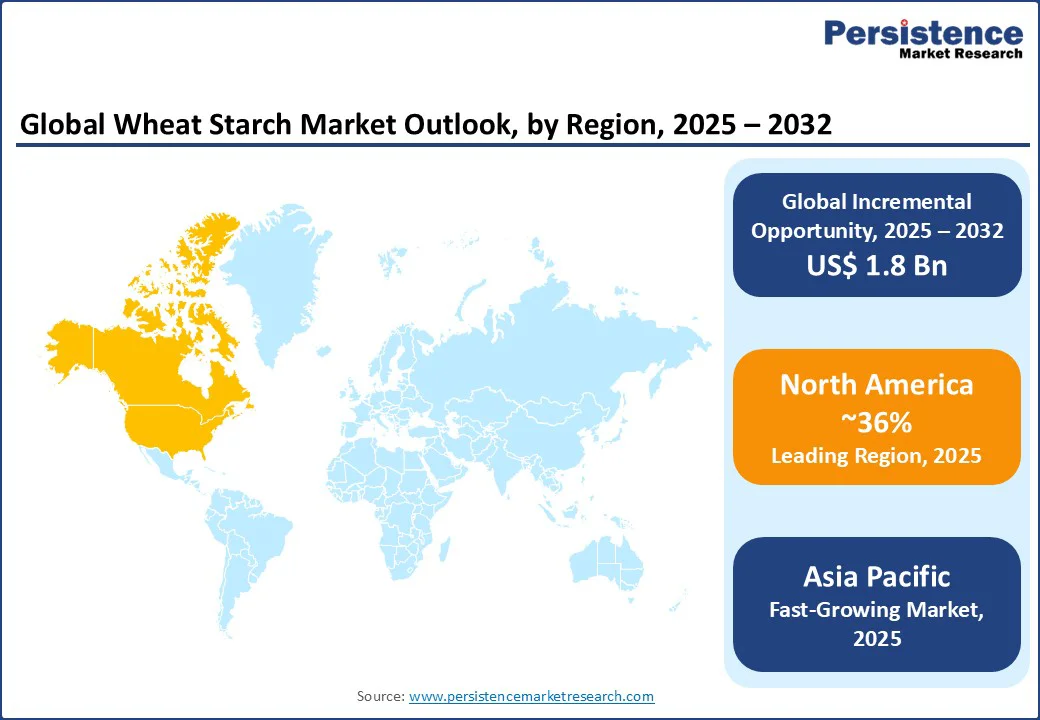ID: PMRREP16843| 189 Pages | 25 Sep 2025 | Format: PDF, Excel, PPT* | Food and Beverages

The global wheat starch market size is likely to be valued at US$6.3 Bn in 2025 and is expected to reach US$8.1 Bn by 2032, growing at a CAGR of 3.7% during the forecast period from 2025 to 2032.
The wheat starch market has experienced steady growth, driven by increasing demand in the food and beverages sector for natural thickeners and stabilizers, rising applications in pharmaceuticals and personal care products, and the expansion of sustainable sourcing practices.
Key Industry Highlights:

| Key Insights | Details |
|---|---|
| Wheat Starch Market Size (2025E) | US$ 6.3 Bn |
| Market Value Forecast (2032F) | US$ 8.1 Bn |
| Projected Growth (CAGR 2025 to 2032) | 3.7% |
| Historical Market Growth (CAGR 2019 to 2024) | 2.9% |
The growing demand for wheat starch in the food and beverages sector is a primary driver of market growth. Wheat starch plays a crucial role in enhancing the texture, consistency, and stability of a wide range of processed food products, including baked goods, sauces, soups, snacks, and confectionery items.
With rising urbanization, increasing disposable incomes, and changing lifestyles, consumers are increasingly turning to convenience and processed food products, further fueling the demand for wheat starch.
The shift toward clean-label ingredients and natural additives has encouraged manufacturers to adopt wheat starch as a versatile, plant-based alternative to synthetic thickeners and stabilizers. The expansion of the bakery, dairy, and ready-to-eat food segments in both developed and emerging regions has amplified the requirement for high-quality wheat starch to maintain product integrity during processing and storage.
Moreover, the beverage industry, including fruit juices, functional drinks, and dairy-based beverages, relies on wheat starch for viscosity control, suspension of particulates, and improved mouthfeel. For instance, companies such as Nestlé and Unilever have incorporated wheat starch in their product formulations to meet consumer demands for natural ingredients and enhanced product quality.
Volatility in raw material prices is a significant restraint for the wheat starch market. Wheat, the primary raw material for starch production, is subject to fluctuations due to seasonal variations, adverse weather conditions, and changing agricultural yields. Extreme weather events such as droughts, floods, or unseasonal rainfall can directly impact wheat output, leading to supply shortages and price spikes.
Additionally, global trade dynamics, including export restrictions, tariffs, and geopolitical tensions, can exacerbate price instability. Rising input costs, including labor, transportation, and energy, further contribute to production expenses, affecting profit margins for manufacturers.
The growing adoption of wheat starch in pharmaceutical and personal care applications presents a significant opportunity for market growth.
In the pharmaceutical sector, wheat starch is widely used as an excipient in tablet formulations, acting as a binder, disintegrant, and filler, ensuring consistent drug delivery and stability. With the rising demand for generic drugs, over-the-counter medications, and nutraceuticals, manufacturers are increasingly relying on high-quality wheat starch to maintain product integrity and comply with stringent regulatory standards.
In the personal care and cosmetics industry, wheat starch is valued for its absorbent, anti-caking, and texturizing properties, making it a preferred ingredient in powders, creams, lotions, and other cosmetic formulations. The trend toward natural and plant-based ingredients in cosmetics has further boosted wheat starch adoption, as consumers increasingly prefer products free from synthetic additives.
Additionally, emerging markets in the Asia Pacific and Latin America are witnessing rapid growth in pharmaceutical production and personal care consumption, creating new demand streams. The dual application potential across pharmaceuticals and personal care provides manufacturers with opportunities for product diversification, revenue expansion, and stronger positioning in high-value markets.
For instance, Wheat starch is widely used as an excipient in tablet formulations, acting as a binder, disintegrant, and filler, ensuring consistent drug delivery and stability. For instance, medications such as Tekturna HCT utilize wheat starch as an inactive ingredient.
Wheat accounts for approximately 45% of the wheat starch market, driven by its abundant cultivation, cost-effectiveness, and established role in traditional processing regions, where it serves as a preferred raw material across food, pharmaceutical, and industrial applications.
Corn is emerging as the fastest-growing source in the starch market, supported by its abundant supply, cost-efficiency, and versatility across multiple applications. Rising consumption in food, beverages, pharmaceuticals, and bio-based industries, coupled with expanding processing facilities in the Asia Pacific, is accelerating demand and strengthening its global market presence.
Food and Beverages lead the wheat starch market with a 40% share, underscoring its critical role in enhancing product texture, stability, and consistency. Widely applied in bakery, confectionery, dairy, and ready-to-eat products, wheat starch supports clean-label trends and rising consumer demand for processed and convenient food options.
Pharmaceuticals represent the fastest-growing application in the wheat starch market, driven by its critical role as an excipient in tablet formulations, serving as a binder, disintegrant, and filler. Rising demand for generic drugs, nutraceuticals, and clean-label formulations is accelerating adoption across global pharmaceutical manufacturing.

Asia Pacific is the fastest-growing region in the wheat starch market, driven by rapid urbanization, changing dietary habits, and the expansion of the regional food processing industry.
Rising disposable incomes across emerging economies such as China, India, Indonesia, and Vietnam are fueling demand for processed and convenience foods, including bakery items, snacks, ready-to-eat meals, and beverages, all of which increasingly incorporate wheat starch as a functional ingredient.
The growing preference for packaged and value-added foods, particularly among younger consumers and urban households, further supports market expansion.
food and beverages, Asia Pacific’s strong pharmaceutical and personal care sectors are boosting wheat starch adoption. The region’s rising healthcare spending, along with the growth of generic drug manufacturing in India and China, is creating a substantial demand for wheat starch as an excipient in tablet formulations.
Simultaneously, cosmetics and personal care brands are leveraging wheat starch for its natural, plant-based properties in skincare and beauty products. Supported by favorable government policies, expanding manufacturing capacities, and increased foreign investments, the Asia Pacific is positioned as a high-potential growth hub, offering significant opportunities for global and regional wheat starch producers.
North America holds a significant 36% share of the global wheat starch market, underpinned by strong demand from the food processing, pharmaceutical, and industrial sectors. The region has a highly developed food and beverage industry, where wheat starch is extensively utilized in bakery, confectionery, dairy, sauces, and ready-to-eat meals to enhance texture, stability, and shelf life. Rising consumer preferences for convenience foods and clean-label ingredients further amplify the need for wheat starch as a natural alternative to synthetic additives.
The pharmaceutical sector in North America also drives growth, with wheat starch widely used as an excipient in drug formulations, supported by the region’s large-scale pharmaceutical manufacturing base.
In addition, industrial applications, including paper, adhesives, and textiles, benefit from the region’s advanced processing technologies and well-established supply chains. The U.S. dominates regional demand, fueled by a robust packaged food market and significant R&D investments, while Canada contributes through its strong agricultural production and expanding food processing sector.
Furthermore, North America’s advanced manufacturing infrastructure, high-quality standards, and innovations in starch modification technologies position it as a global leader. This combination of factors ensures North America maintains a stable and influential role in shaping the wheat starch market’s global trajectory.
Europe is the leading region in the wheat starch market, anchored by key countries such as Germany, France, and the United Kingdom. The region benefits from stringent European Union regulations that emphasize sustainable sourcing, eco-friendly production practices, and the promotion of locally grown agricultural inputs. These factors have created a favorable environment for wheat starch adoption across diverse applications.
Germany plays a central role, where strong demand from the paper and textiles industries supports steady growth. The country’s focus on eco-friendly packaging and industrial sustainability has accelerated the integration of wheat starch into both traditional and emerging applications.
France, meanwhile, demonstrates significant reliance on wheat starch in its bakery industry, where traditional and artisanal baked goods are central to consumer demand. Policy support under the European Green Deal further encourages the use of wheat starch derived from local grains, reinforcing sustainability goals.

The global wheat starch market is moderately consolidated, dominated by global leaders alongside specialized regional players. In North America and Europe, major companies such as Tate & Lyle, Ingredion, ADM, and Cargill lead the sector through capacity expansions, strategic acquisitions, and innovations in sustainable starch solutions.
These players emphasize product diversification, low-glycemic and clean-label variants, and strengthening their supply chains through partnerships and regional investments. By focusing on advanced R&D, eco-friendly sourcing, and collaborations with food and pharmaceutical manufacturers, they continue to expand their reach across high-value applications.
The global wheat starch market is projected to reach US$6.3 billion in 2025.
Increasing demand in the food and beverages sector for natural thickeners, coupled with growth in pharmaceutical applications and sustainable sourcing, are key drivers.
The wheat starch market is poised to witness a CAGR of 3.7% from 2025 to 2032.
Expansion in pharmaceuticals and personal care, alongside innovations in modified starches for clean-label products, presents significant opportunities.
Tate & Lyle PLC, Ingredion Incorporated, and Cargill Incorporated are among the leading players.
| Report Attribute | Details |
|---|---|
| Historical Data/Actuals | 2019 - 2024 |
| Forecast Period | 2025 - 2032 |
| Market Analysis | Value: US$ Bn, Volume: As Applicable |
| Geographical Coverage |
|
| Segmental Coverage |
|
| Competitive Analysis |
|
| Report Highlights |
|
By Source
By Application
By Region
Delivery Timelines
For more information on this report and its delivery timelines please get in touch with our sales team.
About Author